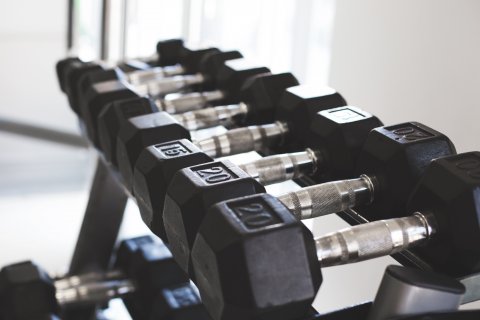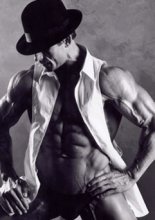You are here
Home ›Principles of Weight Training (Part Two)

In the initial stages of training, your own bodyweight and machines such as Nautilus, Hammer Strength, Cam II, Apex, Strive, and Flex are useful to prepare for more advanced exercises using free weights. The line of motion in machines is "fixed" throughout a specific range of exercise motion, preventing any deviation of movement away from the guided plane.
Thus, the biomechanics of the movement are predetermined and the body is forced to adapt to the machine.
This helps teach beginners how to move the weight in a controlled fashion and compensates for any deficiency in motor control and coordination. Machines also compensate for muscle weakness and muscle imbalance. Chin-ups, push-ups and bar-dips are excellent basic exercises, but difficult for many beginners to perform at first. Cable pull-downs for example, offer an effective alternative to chin-ups, but over time, as the back and arms become stronger based on progressive training methods, it will become possible to advance to standard chin-ups using a chinning bar and even add weight using a dipping belt for added resistance.
Free-moving barbells and dumbbells demand coordinated movement, balance and grip strength, and therefore require greater mental concentration and overall effort. Instead of being forced to adapt to a machine, the lifter can force free weights to adapt to their own body and preferred line of movement. Some people are too big or too small for certain machines; others just don't "fit". Thus one can easily compensate with a free-weight alternative. Free weights mimic real-life movements more closely, especially dumbbells.
In other situations, a machine may be preferred for rehabilitation or for "pumping" the muscle. Machines are convenient and fast. Changing the weight is as simple as inserting a pin. In any case, a combination of both free weights and exercise machines are generally recommended for complete body development with greater emphasis on free weights for building sheer strength, making advances in training or for providing neuromuscular stimulation for sport specific training. Cables, pulleys and adductor/abductor machines provide certain obvious advantages and thus are complimentary. I use everything from time to time, but the "iron" always dominates.
Each exercise designated for a specific muscle group has a fixed number of repetitions and sets. A repetition is one complete movement of an exercise; a set is a fixed number of repetitions. The average number of exercises performed per body part trained is 3-5. The average number of sets performed per exercise is also 3-5. Average isn't necessarily right.

Repetitions vary depending on training objectives, exercise intensity and experience. Bodybuilders use 6-12, powerlifters 2-8, and many fitness advocates looking for muscle tone typically use light weights and rep ranges of 15-20. It really depends on what you're after, although type I, type IIa and type IIb muscle fibers all require stimulation and full recruitment for total and complete muscular development.
Type I or slow twitch fibers respond to lighter weights and higher repetitions. These fibers are designed by nature for continuous, less intense aerobic activity. Type II fibers work in contrast. They fatigue easily, but can handle more weight. They are designed for anaerobic, high-intensity activity. To stimulate both types of type II fibers, which are fast twitch fibers, you need to train with heavier weights and keep the reps under a ceiling of 6 for type IIb and 8-12 for type IIa.
Warm-up sets usually vary between 10-12 reps with light weights, and sometimes as low as 2-6. Warming up is useful to prepare specific muscles for heavier poundage and to "practice" form with total concentration and correct technique. Another basic rule of warm-up relates to body temperature. 5-10 minutes of cardio and a little stretching should be done first before you ever pick up a weight. This will greatly reduce risk of injury to the joints and ties in with a long-term health & fitness commitment. Safety first is a good rule of thumb to practice in the gym; use your head before you use your body.
A study from the University of Florida, Gainesville, studied the effects of a single-set vs. a three-set approach to muscle size and strength to help determine the actual number of sets required to maximize results. Subjects were recreational weightlifters with at least one year of gym experience. Some were asked to reduce training sets to one only per exercise, while others were asked to maintain a strict training volume of three sets per exercise. After 13 weeks of testing, researchers found that both groups significantly increased their muscle size and strength. Thus, the one-set approach was just as effective in promoting muscle growth and strength as the three-set approach.
In contrast to this study, another group of researchers assigned 17 untrained women to either a single-set group or a multiple-set group. Each group was tested for their 1 Repetition Maximum (RM) in the squat and vertical jump height at the beginning and end of the study. Participants trained three days per week for eight weeks. After the eight weeks, the multiple-set group increased 1 RM squat values by 34.7 % and vertical jump height by 11.2%. The single-set group improved 1 RM in the squat by 24.2% and improved just 0.3% in vertical jump height.
The fact that the women were untrained raises controversy. Well-conditioned athletes are an entirely different ball-game, but the truth remains that volume and intensity both play important roles in muscular development and performance. As far as my own training goes, I never employ more than 2 sets per exercise (not including warm-ups) or more than 4 exercises per body part in one workout. I also train each body part only once every 7-10 days, as I've discovered that provided the intensity and load is relatively high, and the quality of execution is excellent, the body can only take so much punishment. After that it's like kicking a dead horse, and if you have good aim, how many shots does it really take?
The jury is still out on knowing exactly how many sets and exercises are absolutely required, but why waste energy? Energy is crucial to conserve after the job is done, especially for natural athletes who prefer not to use pharmaceuticals. A huge amount of biochemical energy is required after the workout is finished to recover, heal and grow. You should leave the gym knowing you can do more, instead of feeling completely exhausted. Your immune system will love you for it.
There will always be differences in the approach and design of workout schedules and how they are arranged. Exercise variation, cross-training and periodization are important concepts associated with the science of exercise physiology. I use them all. Routines can vary depending on the specificity of sport, the anatomy of the individual and the exercise equipment available. Each one of us is unique. I have interviewed hundreds of professional athletes and bodybuilders and, in general, they all have a different take on training.
The most important thing is to understand the basic principles of lifting. Design a structured program, follow some initial guidelines and then modify your program as you go along. Don't change your routine if you are injury-free, improving and making progress; this is the most anyone can ask for. Leave well enough alone. Train hard, train smart and train natural. That's my motto. But how many out there are completely free of injury and making progress with each and every workout?
Change your routine if nothing is happening or work harder. Experience is the greatest teacher and through trial and error you can come up with an effective strategy that challenges both mind and body and most importantly, minimizes risk of injury. If you ask the world's top professional bodybuilders how they train, they all have a different story to tell. Mind you they all take drugs, every one of them. So if you're clean make sure you compare apples to apples.
What works for one may not work for another in the same way. Individual response is a function of genetics. However, there are basic keys of knowledge that apply universally to workout and training success. And donメt make the mistake of training like a bodybuilder if you want to transfer the value of weight training and power onto the field, court, track or ring. Muscle can be built for show or developed for function, and thereメs a big difference between how each is done.
Photo by Shopify Partners from Burst
Principles of Weight Training: Part One
Principles of Weight Training: Part Three

As always, stay well and live free!
Dr.C
- Log in to post comments